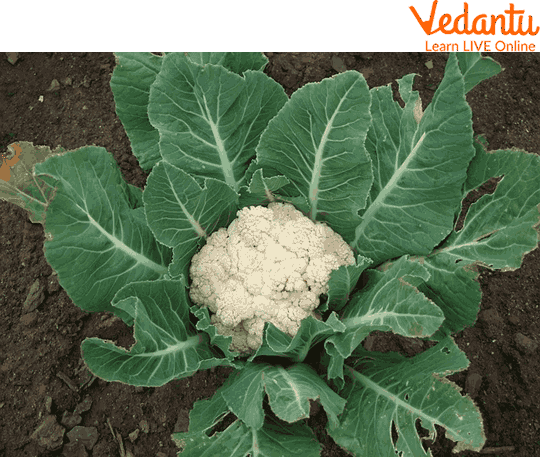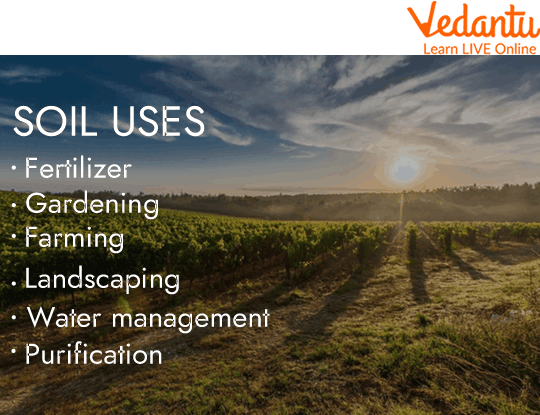




Why Is Soil Important in Our Daily Lives?
Since everything (including life) arises from and returns to the soil, the soil is the most valuable resource in this cosmos. The study of soil is crucial for humans because it provides food for millions of living things, both vegetarian and non-vegetarian, who depend on it for survival. Since soil is the largest storehouse of carbon, it is known as the "backbone of life," and any changes to the soil make life more challenging. We will be learning about the uses of soil in the article.
What is Soil?
Soil is a thin layer covering the earth's surface. The material which this thin layer is made of is known as soil. It is made from weathering rocks. It is a mixture of many particles which include minerals, water, plants, animals, etc.
Based on texture, soil can be classified into three main types:
Sand
Silt
Clay
How is Clayey Soil Useful for Crops?
Wheat and other crops are cultivated in fine clay soil because they are fertile and rich in humus. Loamy soils are used to cultivate lentils. In sandstones or loamy soil, cotton is grown. It can hold a lot of water effectively. The organic stuff is plentiful in clayey soil. Cereals like wheat grow well in loamy and clayey soils. Clayey soil's ability to store water helps crops like rice, which need more water to develop, and flourish. Humus, which enhances soil structure and offers water and minerals, is the organic component of soil. The inorganic component of soil is composed of rock that has been gradually broken down into smaller particles of varying sizes, including sand, silt, and loam.
One of the major uses of clay soil is that it retains the soil moisture and is rich in organic minerals so it is considered good for growing crops like wheat, gram, paddy, etc.

Crop in Clayey Soil
What are the Various Uses of Soil?
The various uses of soil include:
Inorganic particles that are weathered from rock and contain a variety of minerals make up soil.
They serve as a platform for plant growth, which is then utilised to make things like food, clothing, toys, and pharmaceuticals.
It contains a variety of essential nutrients for plants.
It facilitates the construction process.
It serves a variety of religious reasons.
Clay is used to making pottery and ceramics.
Additionally, dirt is an ingredient in beauty cosmetics.
It is employed in the production of skin ointments, anticancer medications, TB medications, and antibiotics.
It is used in wastewater treatment facilities.
Sometimes, the soil is also used for cleansing.

Uses of Soil
Why is Soil Important?
Soil is a very crucial component for both living beings and the environment. Soil provides us with the necessary minerals required to live. It puts up food on our plates. It supports the plants which are the reason for providing us with oxygen. Now, let’s answer the question: how is soil important for living beings and the environment?
A World That is Fed by Healthy Soil
Food is derived from the soil. The fundamental nutrition cycling for plants and animals is provided by soil, which is made up of minerals, water, air, and organic matter. Soil also serves as a foundation for many essential ecosystem functions, including the production of feed, fuel, fibre, and medical products.
Like Natural Gas or Oil, the Soil is a Limited Resource
Since soil cannot be replaced, its loss cannot be made up in the course of a human lifetime. One centimetre of soil can take hundreds of years to build from the parent rock, but then that centimetre of topsoil can be washed away by erosion in just one year.
Climate Change Can Be Lessened by Soil
More than twice as much terrestrial organic carbon is stored in the soil as there is in vegetation. Soil alleviates climate change via carbon absorption and a decrease in greenhouse gas emissions, in addition to assisting in the provision of clean water, preventing desertification, and enhancing resilience to flood and drought.
Soil Is Vibrant and Lively
Soil contains 25% of the biological diversity on the globe. In addition to the billions of bacteria, fungi, and protozoans present in the soil, there are also thousands of insects, mites, and worms.

Owls of the Zoo
Summary
In this article, we have learnt various important facts about soil. We also learnt that soil is where plants get their mineral nutrients. The loose outer layer that covers the earth's surface is known as soil. The chemical makeup of the soil, terrain, the existence of living things, the weather, and time all affect how healthy the soil is.
We learnt that the properties and fertility of soil can also be altered by agricultural history and practice. Inorganic mineral matter, organic matter, water and air, and living life are the four main components of soil. Here, in this article, we have now learnt why soil is important for us, and what the soil provides to us. Soil is very crucial and now we know the reasons.
FAQs on Uses of Soil: Meaning, Benefits & Examples
1. What is soil and what is it made of?
Soil is the top layer of the Earth's surface where plants grow. It is a complex mixture of four main ingredients: minerals (from weathered rocks), organic matter (from decomposed plants and animals), water, and air. This rich combination provides the support and nutrients necessary for life.
2. What are the most important uses of soil in our daily lives?
Soil is essential for life and has many important uses. The primary uses include:
- Agriculture: It is the medium for growing crops, fruits, and vegetables that provide us with food.
- Construction: Soil, especially clay, is a key material for making bricks, tiles, and pottery. It also provides the foundation for our homes and buildings.
- Water Filtration: It acts as a natural filter, purifying rainwater as it seeps underground, making it safe to drink.
- Habitat: Soil is a home to countless organisms, from tiny bacteria and fungi to larger creatures like earthworms and insects.
3. How is soil used in farming and agriculture?
In agriculture, soil serves several critical functions. It provides a firm anchor for plant roots, holding them securely. More importantly, it acts as a reservoir of water and essential nutrients, which plants absorb through their roots to grow healthy and strong. Healthy soil is the foundation of successful farming.
4. Why is soil considered a vital natural resource for all living things?
Soil is considered a vital natural resource because it forms the basis of most terrestrial ecosystems. Plants, which are the primary producers in the food chain, depend on soil for growth. Animals then eat these plants, and other animals eat them. Without healthy soil to support plant life, the entire food chain on land would collapse. It also plays a key role in cleaning our water and regulating the climate.
5. How can different types of soil, like clay and sand, have different uses?
The properties of different soil types determine their best uses. For instance:
- Clay soil: Composed of very fine particles, it is sticky when wet and becomes hard when dry. This makes it ideal for making pottery, bricks, and cement.
- Sandy soil: Has large, coarse particles that do not hold water well. While not great for most farming, it is widely used in construction as a fill material and in filtration systems.
- Loam soil: A mix of sand, silt, and clay, it is considered the best for agriculture because it holds moisture but also drains well, providing perfect conditions for plant roots.
6. How does soil help in cleaning our water?
Soil acts as a giant natural filter. As water from rain or irrigation seeps through its layers, the physical particles of sand and silt trap impurities and sediments. Furthermore, the billions of microorganisms living in the soil break down pollutants and contaminants, effectively purifying the water before it joins underground sources like aquifers. This natural process is crucial for maintaining clean groundwater.
7. Besides large animals like worms, what tiny organisms live in soil and why are they important?
Soil is teeming with microscopic life, such as bacteria, fungi, and algae. These tiny organisms are incredibly important because they act as nature's recyclers. They decompose dead organic matter like fallen leaves and dead animals, breaking them down into simpler nutrients. This process, called decomposition, creates fertile humus and releases essential nutrients back into the soil, making them available for new plants to use.
8. What is the difference between soil and dirt?
While often used to mean the same thing, there's a key scientific difference. Soil is a living, dynamic ecosystem containing minerals, organic matter, and a vast community of organisms that supports plant life. Dirt, on the other hand, is essentially displaced, lifeless soil. It's the material you might find on your clothes or floor, separated from its natural environment and lacking the structure and biological activity to support growth.









